Abstract
A study of serological, bacteriocine and phage typing of Serratia marcescens was made. Specific O-antisera of adequate titre were relatively simple to prepare but H-antisera exhibited many heterologous agglutination reactions amongst the type strains. Most of these cross-reactions were not reproduced when immobilization tests with H-sera were performed. Direct haemagglutination tests were used to establish the presence of fimbriae amongst the H-type strains and the results of agglutination tests with non-fimbriate variants of strains indicated that fimbrial antibody in high titre was present in some sera. Replicate typing of 100 pairs of cultures by the phage-typing method indicated that small variations in pattern were common and that larger variations occurred occasionally. Therefore differences in pattern of less than two strong reactions should not be taken as evidence that strains can be distinguished. Cultures of S. marcescens, 273 in total, from six outbreaks of infection in British and European hospitals were typed by O-serology, H agglutination and immobilization tests, phage typing and bacteriocine susceptibility by a cross-streaking method. The typability of strains by each method was high but the results suggested that no single method was sufficiently discriminating to be used alone for typing. Comparison of the H-type and typing patterns of members of the same O serogroup from incidents of infection showed that reliable results were obtained by H-typing or by phage and bacteriocine typing after the application of the appropriate 'difference' rule. The greatest discrimination between strains of the same O-group was obtained by the use of H-typing or phage typing.
Full text
PDF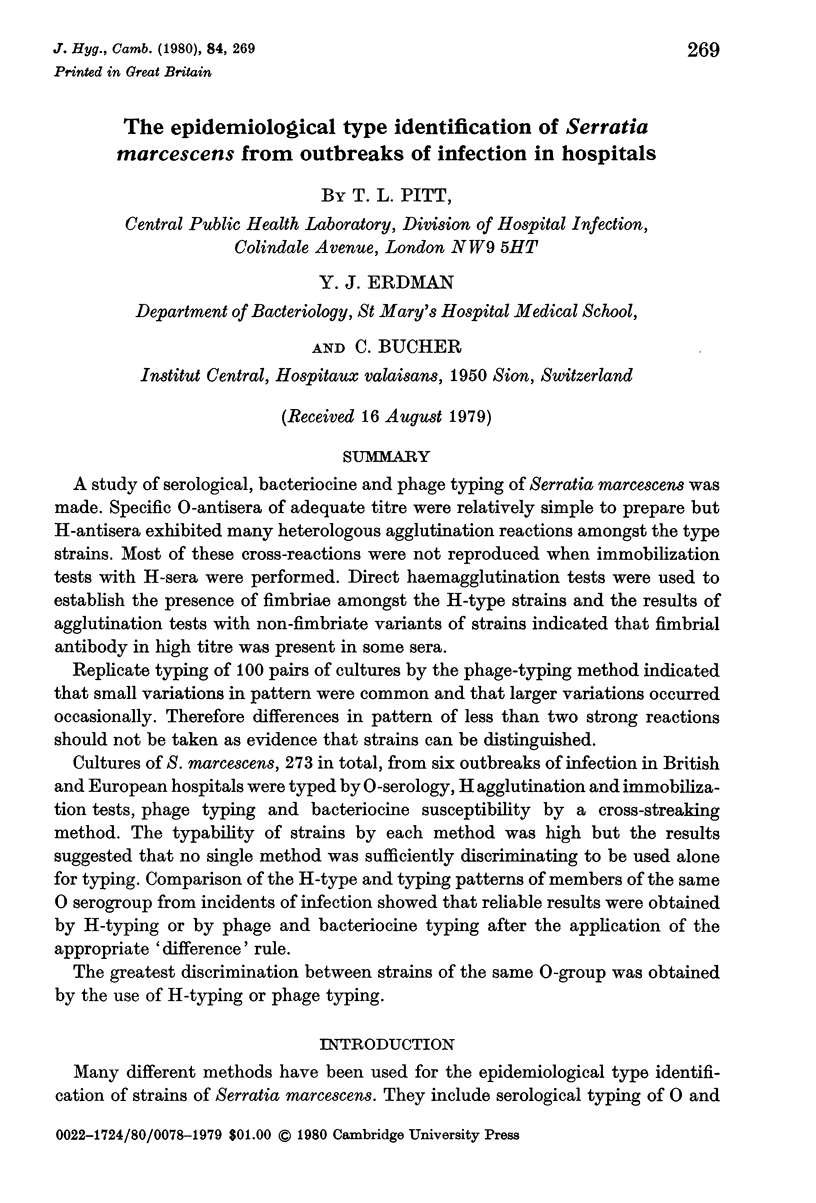
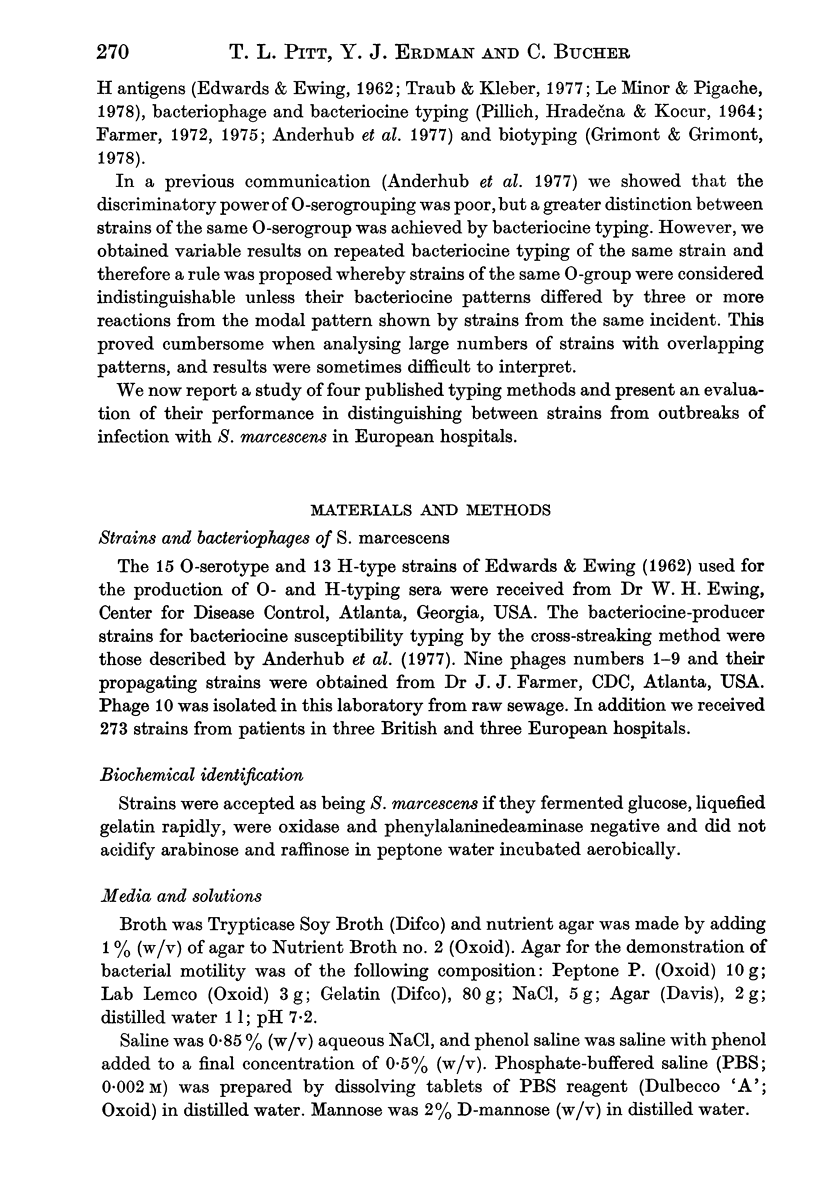
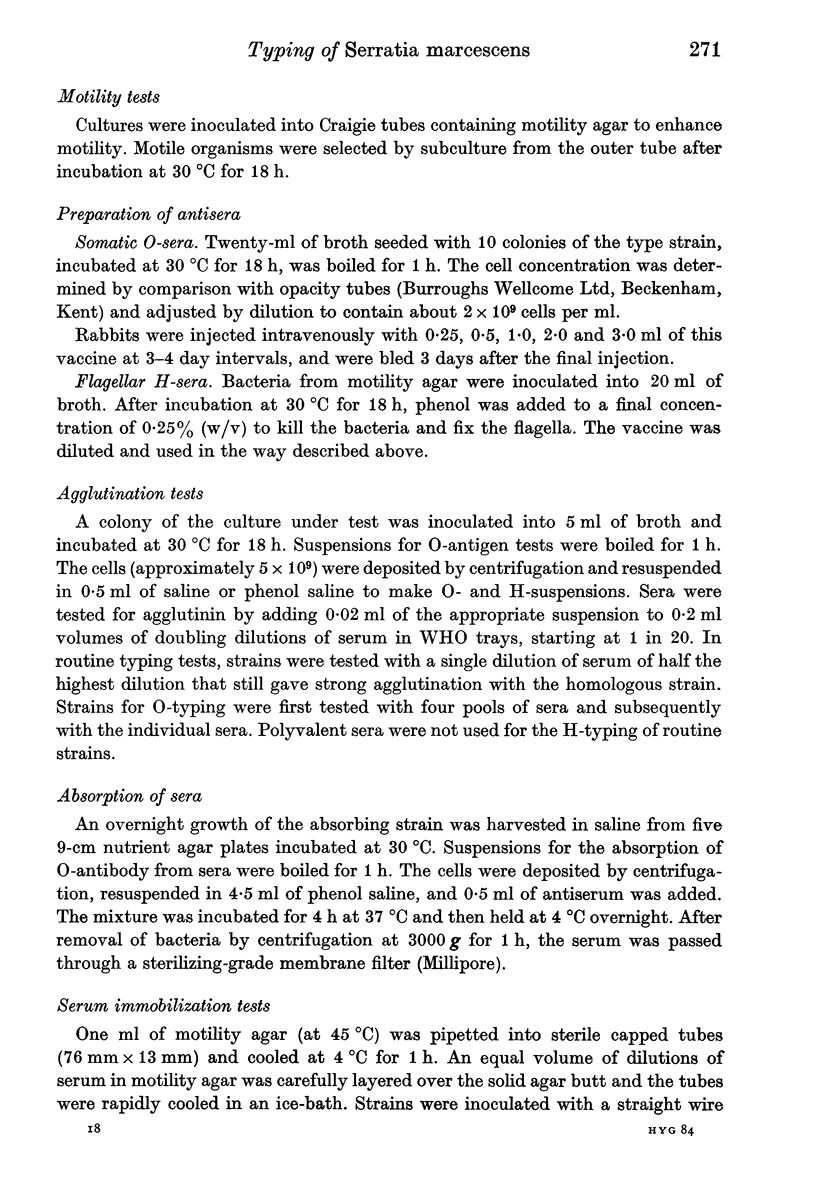
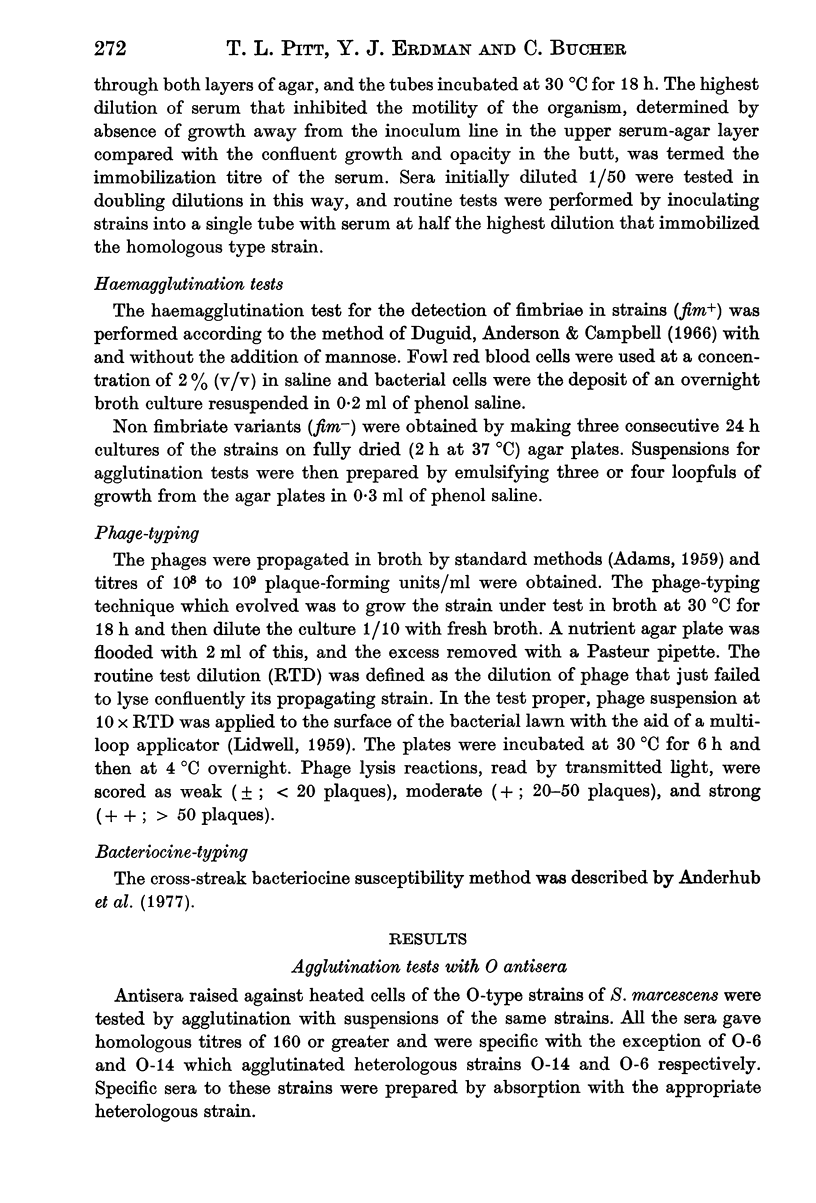
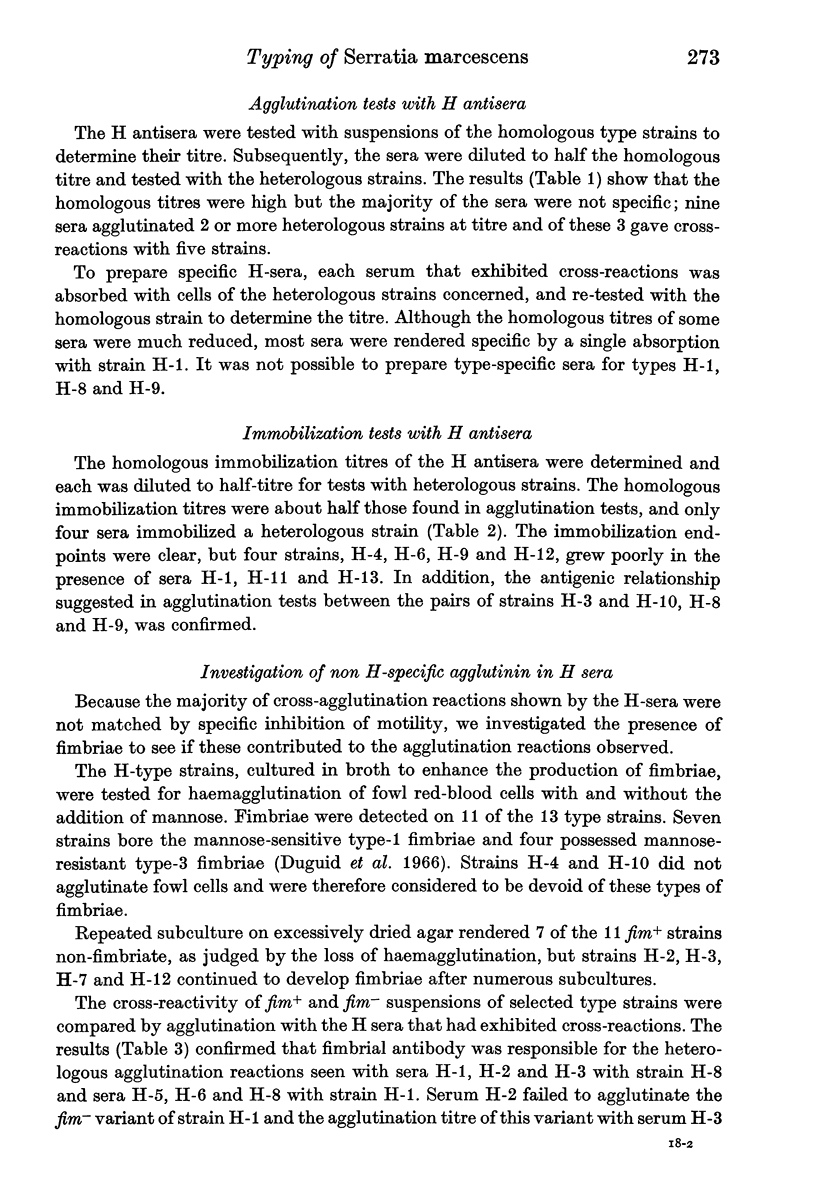

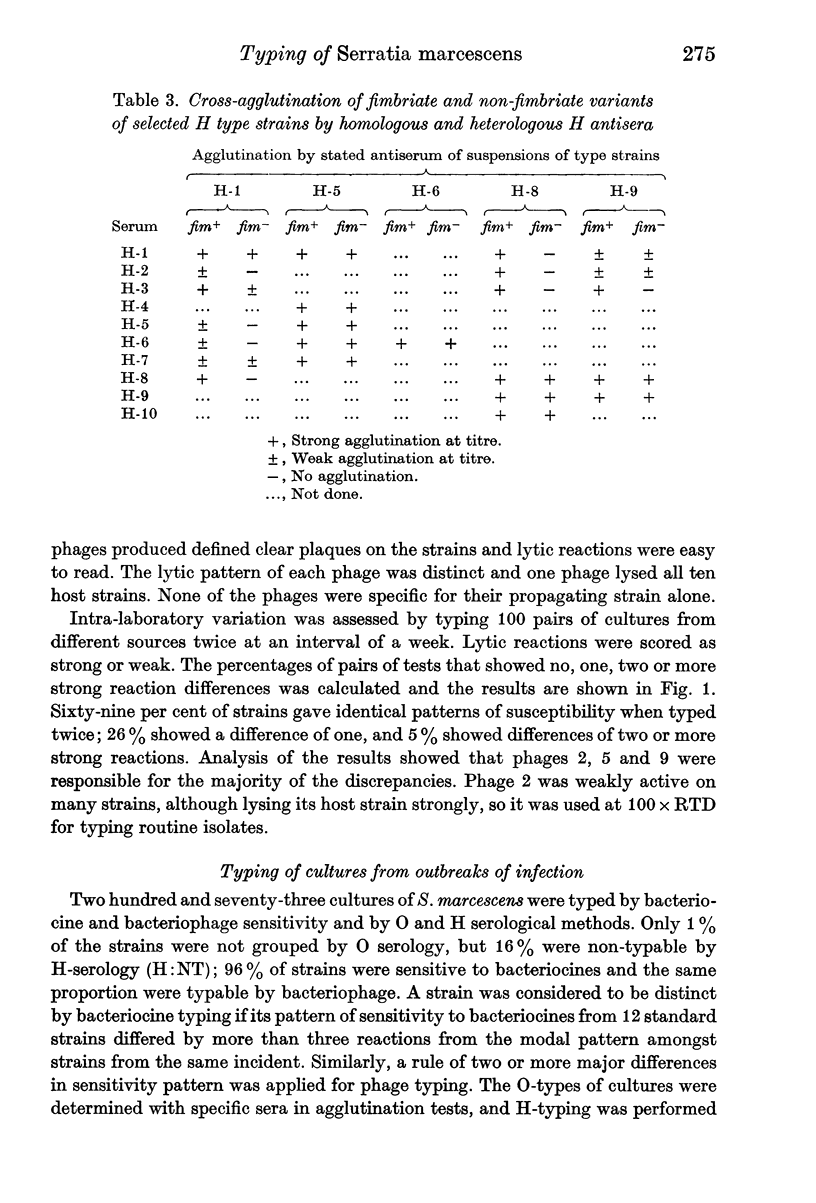
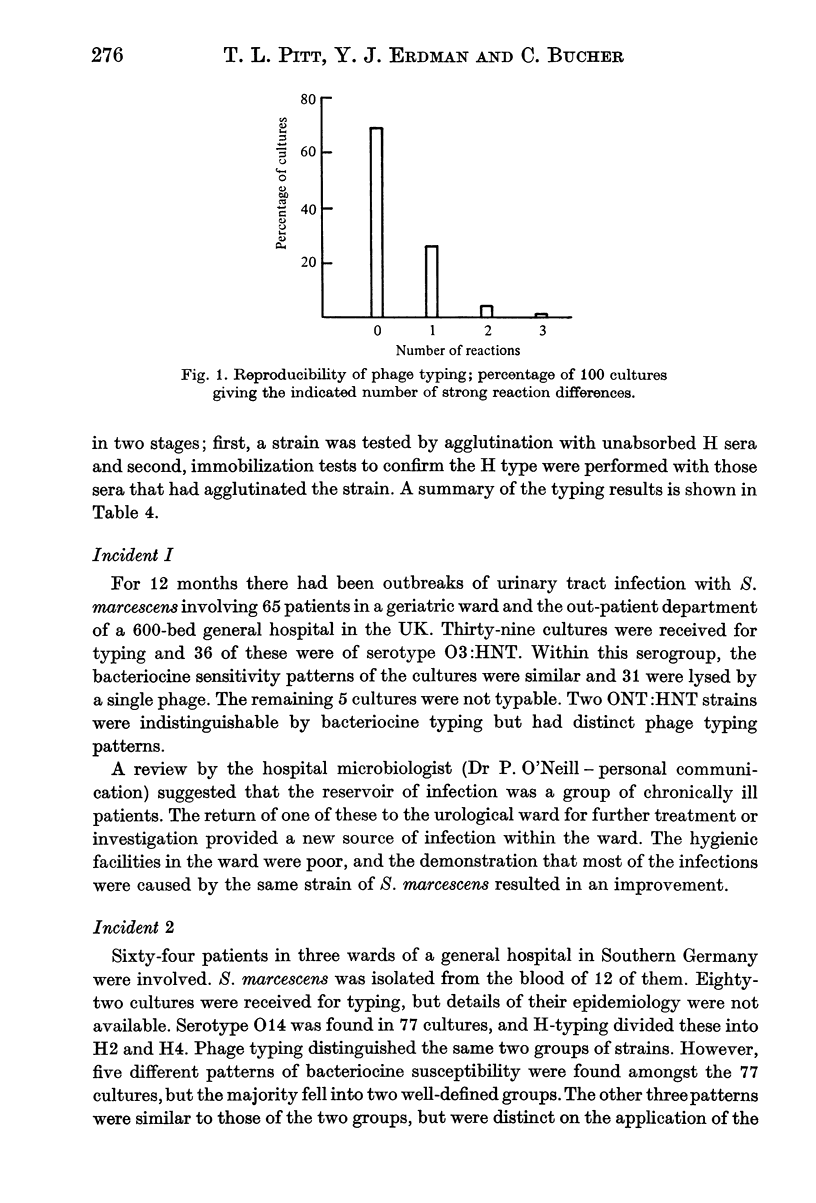
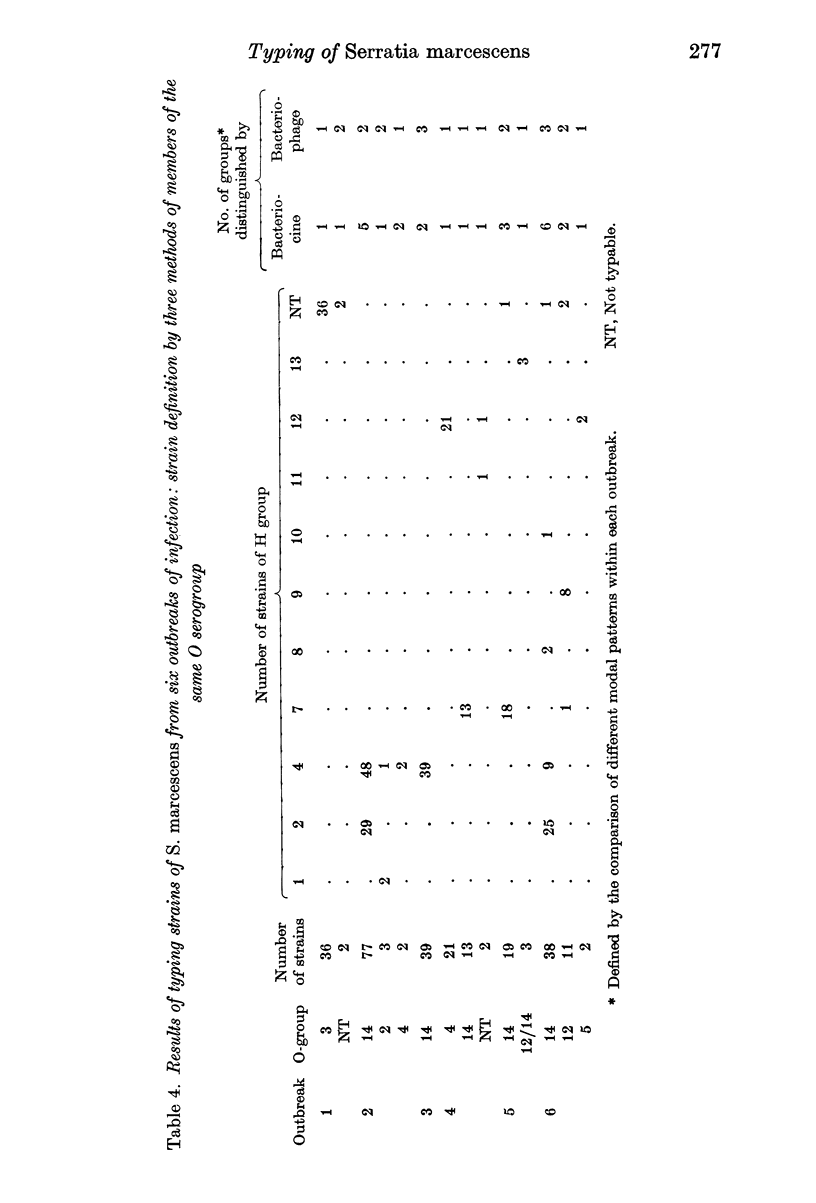
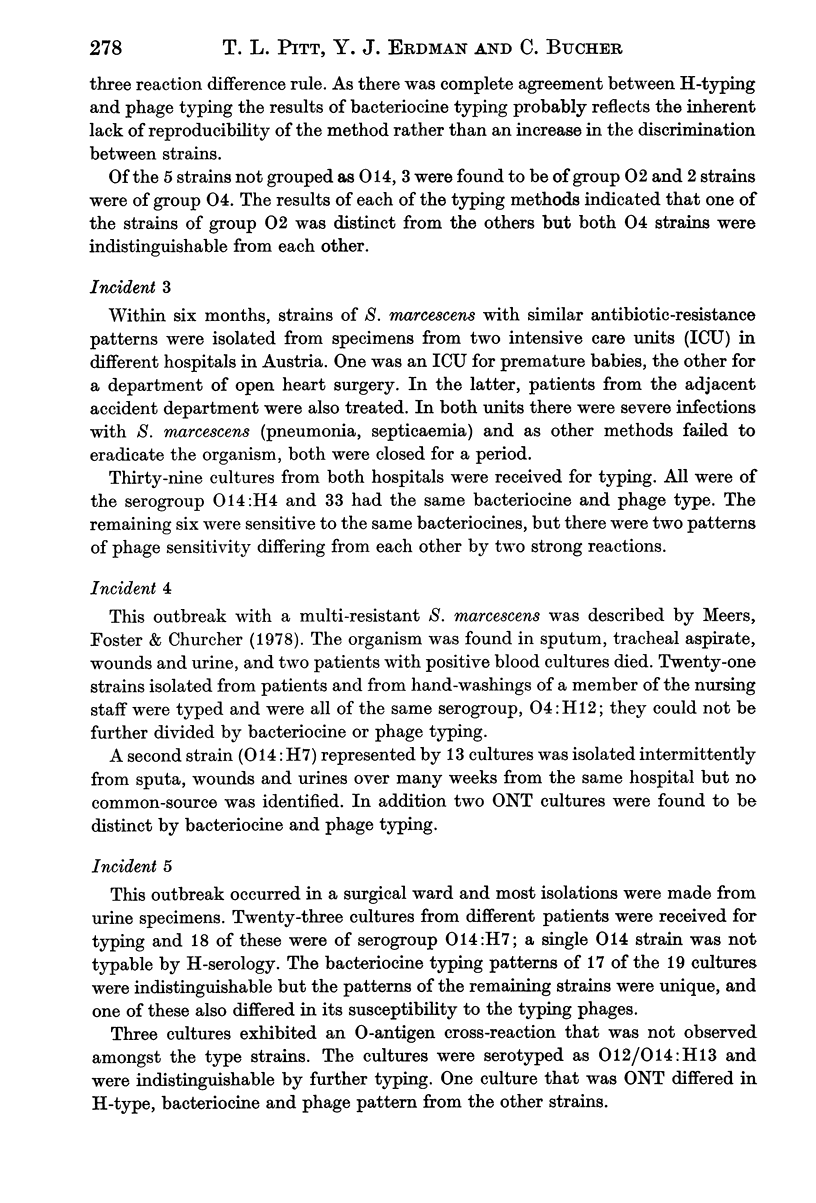
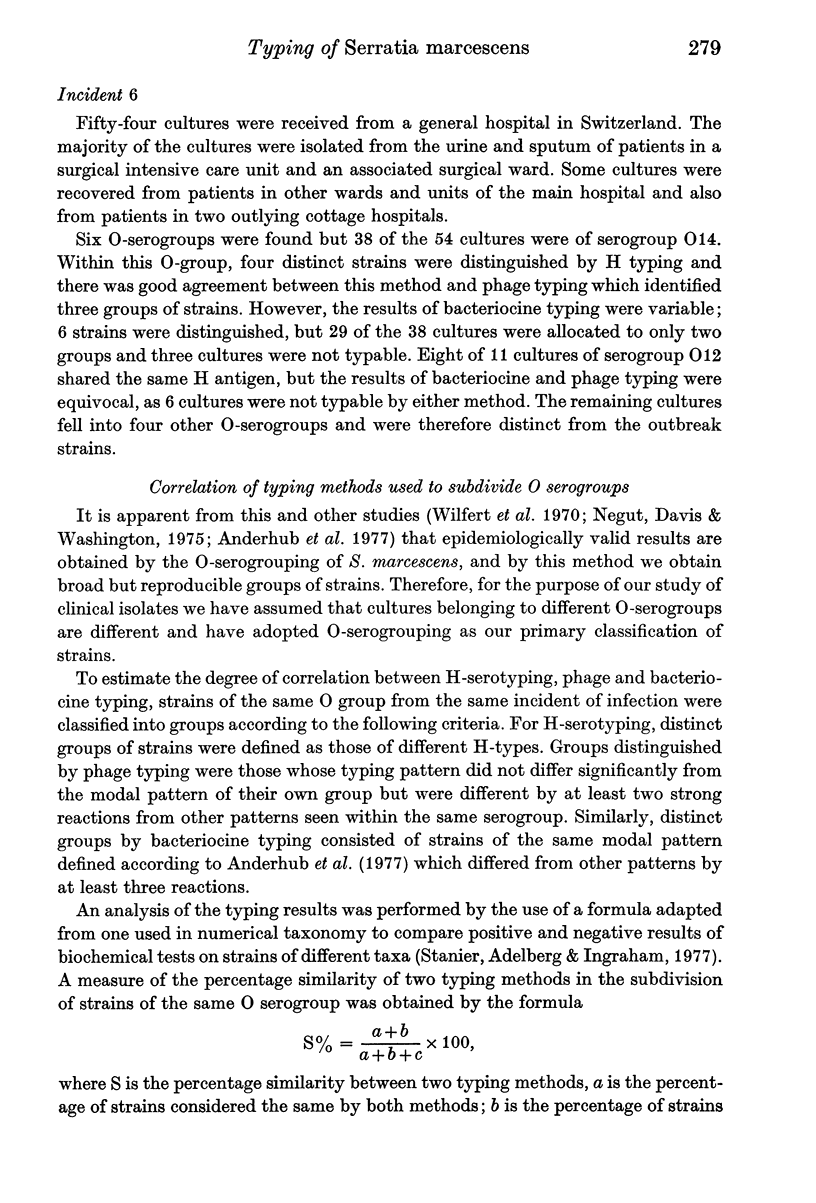
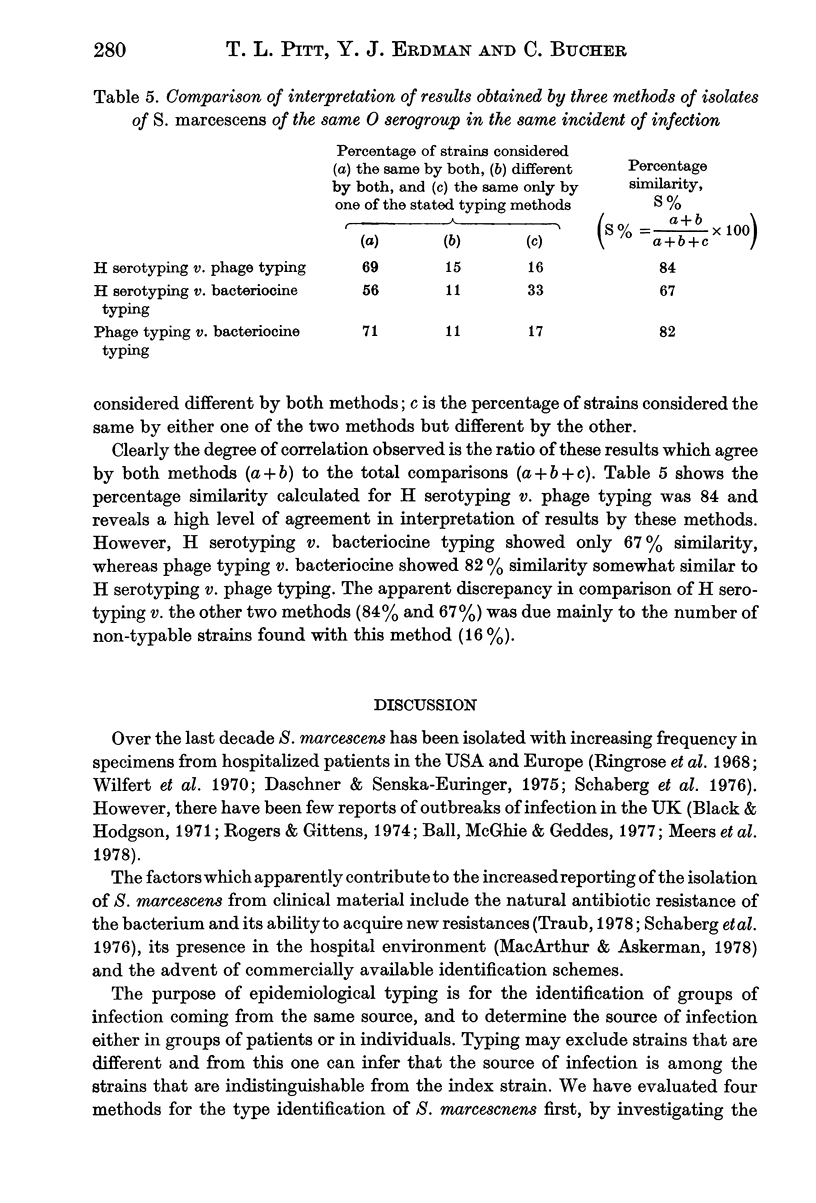

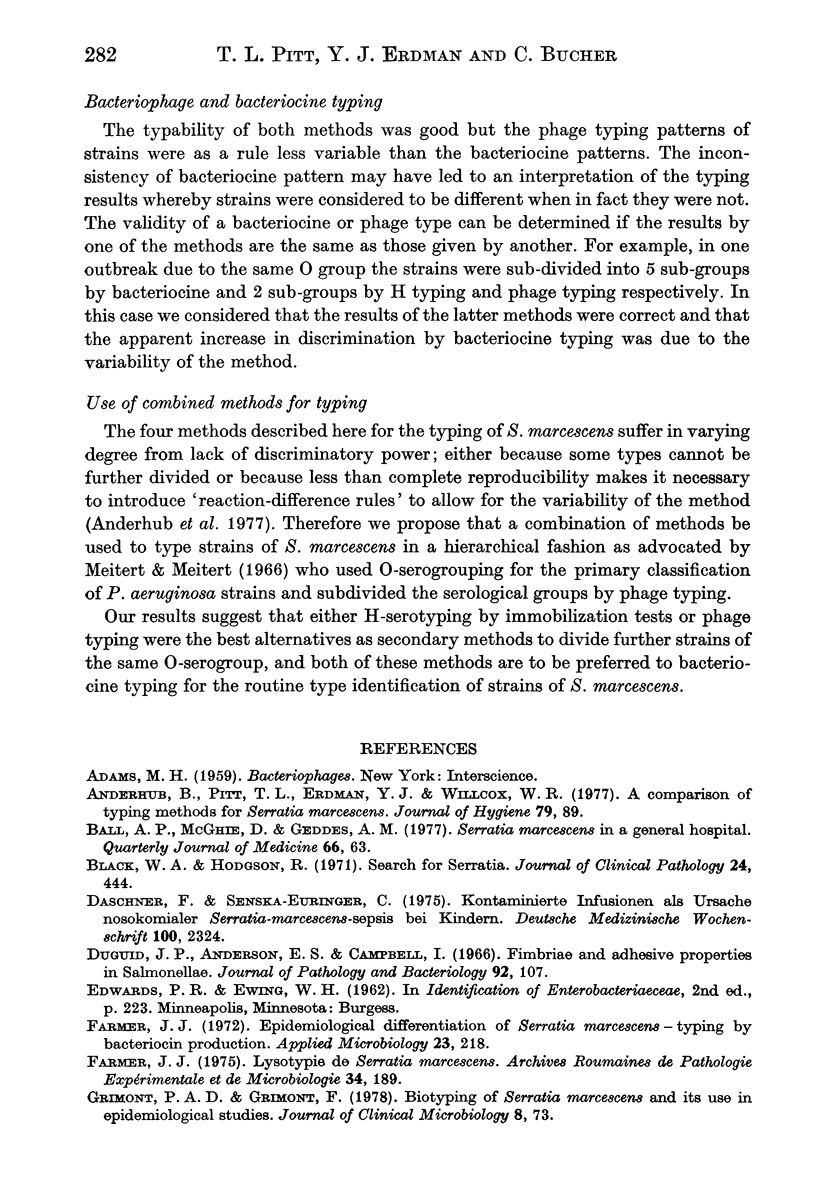
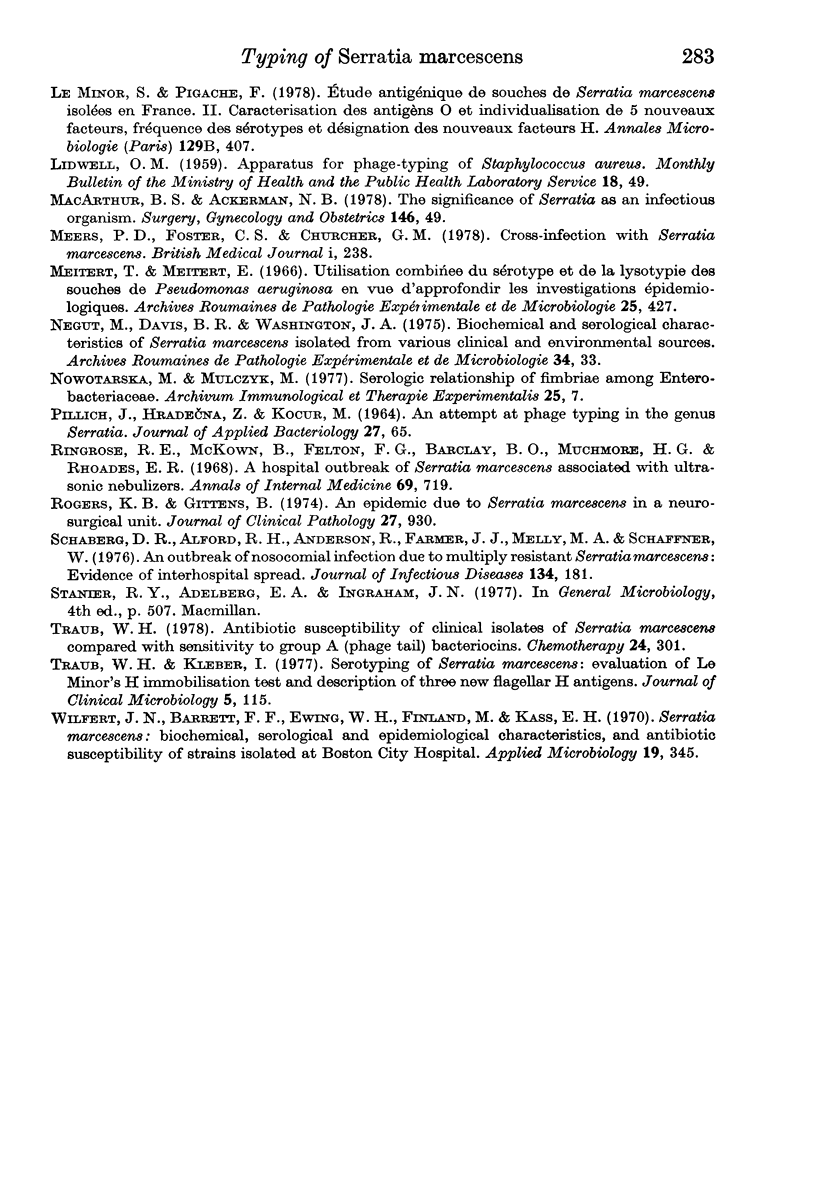
Selected References
These references are in PubMed. This may not be the complete list of references from this article.
- Anderhub B., Pitt T. L., Erdman Y. J., Willcox W. R. A comparison of typing methods for Serratia marcescens. J Hyg (Lond) 1977 Aug;79(1):89–102. doi: 10.1017/s0022172400052888. [DOI] [PMC free article] [PubMed] [Google Scholar]
- Ball A. P., McGhie D., Geddes A. M. Serratia marcescens in a general hospital. Q J Med. 1977 Jan;46(181):63–71. [PubMed] [Google Scholar]
- Black W. A., Hodgson R. Search for Serratia. J Clin Pathol. 1971 Jul;24(5):444–448. doi: 10.1136/jcp.24.5.444. [DOI] [PMC free article] [PubMed] [Google Scholar]
- Daschner F., Senska-Euringer C. Kontaminierte Infusionen als Ursache nosokomialer Serratia-marcescens-Sepsis bei Kindern. Dtsch Med Wochenschr. 1975 Nov 7;100(45):2324–2328. doi: 10.1055/s-0028-1106543. [DOI] [PubMed] [Google Scholar]
- Duguid J. P., Anderson E. S., Campbell I. Fimbriae and adhesive properties in Salmonellae. J Pathol Bacteriol. 1966 Jul;92(1):107–138. doi: 10.1002/path.1700920113. [DOI] [PubMed] [Google Scholar]
- Farmer J. J., 3rd Epidemiological differentiation of Serratia marcescens: typing by bacteriocin production. Appl Microbiol. 1972 Feb;23(2):218–225. doi: 10.1128/am.23.2.218-225.1972. [DOI] [PMC free article] [PubMed] [Google Scholar]
- Grimont P. A., Grimont F. Biotyping of Serratia marcescens and its use in epidemiological studies. J Clin Microbiol. 1978 Jul;8(1):73–83. doi: 10.1128/jcm.8.1.73-83.1978. [DOI] [PMC free article] [PubMed] [Google Scholar]
- LIDWELL O. M. Apparatus for phagetyping of Staphylococcus aureus. Mon Bull Minist Health Public Health Lab Serv. 1959 Mar;18:49–52. [PubMed] [Google Scholar]
- Le Minor S., Pigache F. Etude antigénique de souches de Serratia marcescens isolées en France. II.--Caractérisation des antigènes O et individualisation de 5 nouveaux facteurs, fréquence des sérotypes et désignation des nouveaux facteurs H. Ann Microbiol (Paris) 1978 Oct;129 B(3):407–423. [PubMed] [Google Scholar]
- Meers P. D., Foster C. S., Churcher G. M. Cross-infection with Serratia marcescens. Br Med J. 1978 Jan 28;1(6107):238–239. doi: 10.1136/bmj.1.6107.238-d. [DOI] [PMC free article] [PubMed] [Google Scholar]
- Meitert T., Meitert E. Utilisation combinée du sérotypage et de la lysotypie des souches de Psuedomonas aeruginosa en vue d'approfondir les investigations épidémiologiques. Arch Roum Pathol Exp Microbiol. 1966 Jun;25(2):427–434. [PubMed] [Google Scholar]
- Neguţ M., Davis B. R., Washington J. A., 2nd Biochemical and serological characteristics of Serratia marcescens isolated from various clinical and environmental sources. Arch Roum Pathol Exp Microbiol. 1975 Jan-Jun;34(1-2):33–39. [PubMed] [Google Scholar]
- Nowotarska M., Mulczyk M. Serologic relationship of fimbriae among Enterobacteriaceae. Arch Immunol Ther Exp (Warsz) 1977;25(1):7–16. [PubMed] [Google Scholar]
- Ringrose R. E., McKown B., Felton F. G., Barclay B. O., Muchmore H. G., Rhoades E. R. A hospital outbreak of Serratia marcescens associated with ultrasonic nebulizers. Ann Intern Med. 1968 Oct;69(4):719–729. doi: 10.7326/0003-4819-69-4-719. [DOI] [PubMed] [Google Scholar]
- Rogers K. B., Gittens B. Proceedings: An epidemic due to Serratia marcescens in a neurosurgical unit. J Clin Pathol. 1974 Nov;27(11):930–930. doi: 10.1136/jcp.27.11.930-e. [DOI] [PMC free article] [PubMed] [Google Scholar]
- Schaberg D. R., Alford R. H., Anderson R., Farmer J. J., 3rd, Melly M. A., Schaffner W. An outbreak of nosocomial infection due to multiply resistant Serratia marcescens: evidence of interhospital spread. J Infect Dis. 1976 Aug;134(2):181–188. doi: 10.1093/infdis/134.2.181. [DOI] [PubMed] [Google Scholar]
- Traub W. H. Antibiotic susceptibility of clinical isolates of Serratia marcescens compared with sensitivity to group A (phage tail) bacteriocins. Chemotherapy. 1978;24(5):301–313. doi: 10.1159/000237797. [DOI] [PubMed] [Google Scholar]
- Traub W. H., Kleber I. Serotyping of Serratia marcescens: evaluation of Le Minor's H-immobilization test and description of three new flagellar H antigens. J Clin Microbiol. 1977 Feb;5(2):115–121. doi: 10.1128/jcm.5.2.115-121.1977. [DOI] [PMC free article] [PubMed] [Google Scholar]
- Wilfert J. N., Barrett F. F., Ewing W. H., Finland M., Kass E. H. Serratia marcescens: biochemical, serological, and epidemiological characteristics and antibiotic susceptibility of strains isolated at Boston City Hospital. Appl Microbiol. 1970 Feb;19(2):345–352. doi: 10.1128/am.19.2.345-352.1970. [DOI] [PMC free article] [PubMed] [Google Scholar]


